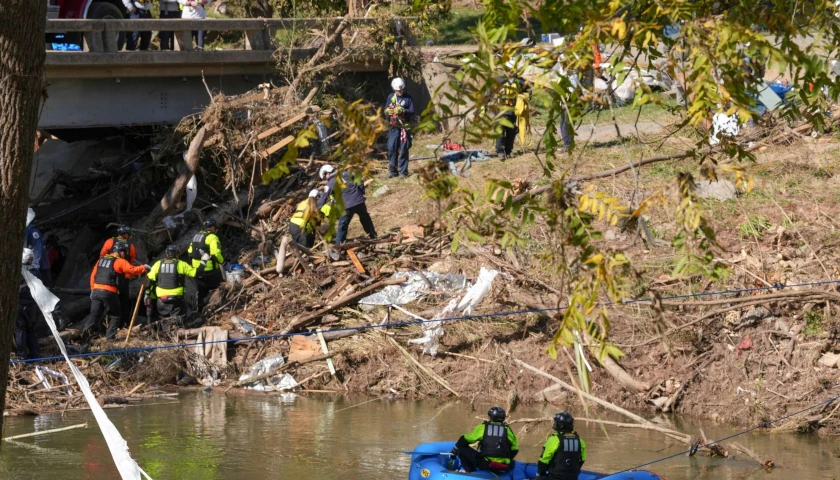According to a county official in Texas, toxic wastewater used to put out a fire after a train derailed in East Palestine, Ohio was carried to a suburb of Houston for disposal. According to the Ohio Emergency Management Agency, most of the contaminated soil is going to Michigan.
The wastewater is being delivered to Texas Molecular, a company that disposes of hazardous material by injecting it into the ground.
According to Harris County, Texas Judge Lina Hidalgo the county first learned about the wastewater transfer on Wednesday from the flaming derailment in East Palestine, Ohio, on February 3rd that forced evacuations as dangerous chemicals were discharged from five wrecked tanker rail cars carrying vinyl chloride that were in risk of exploding.
“I and my office heard today that ‘firefighting water’ from the East Palestine, Ohio, train derailment is slated to be disposed of in our county,” Harris said.
The Texas Commission on Environmental Quality confirmed to The Ohio Star that Texas Molecular “is receiving liquid waste from the Ohio train derailment for storage and ultimate disposal. TM Deer Park is authorized to accept and manage a variety of waste streams, including vinyl chloride, as part of their RCRA hazardous waste permit and underground injection control permit.”
According to Texas Molecular they have experience handling this kind of disposal.
“Our technology safely removes hazardous constituents from the biosphere. We are part of the solution to reduce risk and protect the environment, whether in our local area or other places that need the capabilities we offer to protect the environment,” the company said.
According to Hidalgo, Texas Molecular told county officials on Thursday that it had received 500,000 gallons of firefighting water and that 30 trucks per day will bring another 1.5 million gallons to the site.
Additionally, the delivery raises concerns about the modes of transportation, including trains, as well as the potential health effects on the individuals involved in the transfers and the communities in between the Ohio crash site and the disposal location in Deer Park.
Harris County, Texas is one of a small number of existing locations for the disposal of hazardous commercial waste. According to Hidalgo, the county has about 10 injection wells that can accept the waste. However, there are comparable facilities in Vickery, Ohio, and Romulus, Michigan, both of which are closer to the crash site and could manage the wastewater.
“There may be logistical reasons for all of this. There may be economic reasons. Perhaps Texas Molecular outbid the Michigan facility. It doesn’t mean there’s something nefarious going on, but we do need to know the answer to this question,” Hidalgo said.
According to Dr. George Guillen, the executive director of the Environmental Institute of Houston, the risk to the public is minimal but “It’s … very, very toxic.”
“This injection, in some cases, is usually 4,000 or 5,000 feet down below any kind of drinking water aquifer,” said Guillen, a University of Houston-Clear Lake professor of biology and environmental science.
Moreover, Ohio Emergency Management said that work to remove the contaminated soil from the derailment site started on Thursday.
Norfolk Southern brought in large dump trucks at the request of the Ohio Environmental Protection Agency (EPA) in order to transport contaminated soil to the Michigan-based U.S. Ecology Wayne Disposal, a licensed site for the disposal of hazardous waste. According to Ohio Emergency Management, Norfolk Southern will safely manage and dispose of the waste in a continual effort.
Norfolk Southern has already removed 4,832 cubic yards of soil from the ground, and as cleanup work continues, further soil removal may be necessary. When digging up the tracks and removing the soil underneath, the dump trucks will immediately haul that soil away and take it to a proper disposal facility.
Also, the immediate area of the derailment has seen the removal of 1,715,433 gallons of contaminated liquid. Texas Molecular received the majority of the 1,133,933 gallons transported away from the site. Vickery Environmental in Vickery, Ohio, has received a smaller quantity of waste.
The Ohio Star asked the Ohio EPA why it selected these locations and if it considered alternate locations but did not hear back before press time.
– – –
Hannah Poling is a lead reporter at The Ohio Star and The Star News Network. Follow Hannah on Twitter @HannahPoling1. Email tips to [email protected]
Photo “Texas Molecular” by Texas Molecular.





